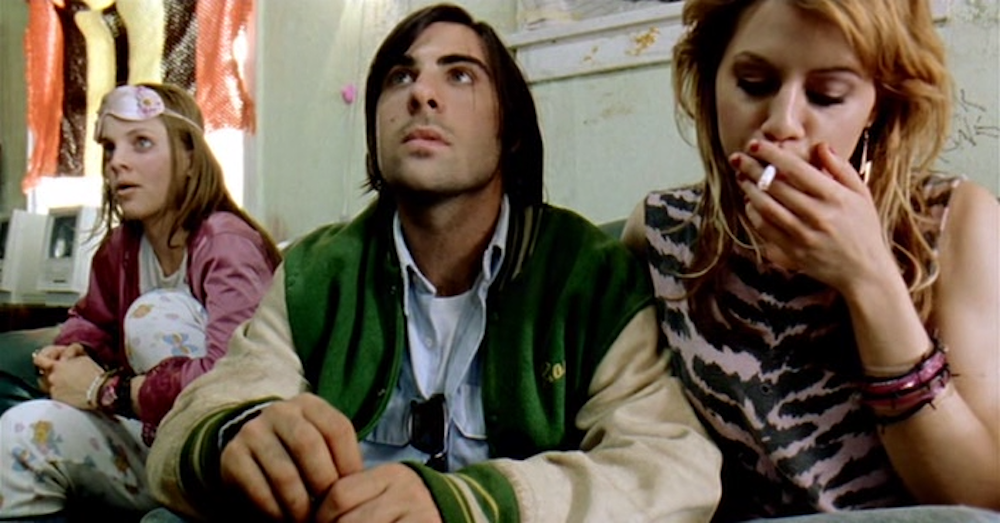Directed by: Jonas Åkerlund
Starring: Jason Schwartzman, Brittany Murphy, Mena Suvari, Mickey Rourke, John Leguizamo
Released in 2002, Spun is a darkly comedic, hyper-stylized look into the chaotic and often grotesque world of methamphetamine users. Directed by Swedish music video veteran Jonas Åkerlund, the film captures a 3-day drug binge through the eyes of Ross (Jason Schwartzman), a college dropout caught in a surreal whirlwind of addiction, dysfunction, and delusion.
Åkerlund, known for his rapid-cut editing and kinetic camera work, brings a visual intensity that mirrors the drug-induced paranoia and mania of its characters. This is Trainspotting on a sugar crash—with more neon, more sweat, and less sympathy.
1. Visual Style & Editing
Åkerlund’s direction is relentless and distinctive. The camera never sits still—cutting rapidly between grotesque close-ups, hallucinations, and spinning angles. The erratic visual language captures the frenzied, uncomfortable rhythm of meth use with unsettling accuracy.
2. Strong, Unhinged Performances
-
Brittany Murphy shines as Nikki, the drug dealer’s girlfriend—sweet, damaged, and tragically chaotic.
-
Mickey Rourke gives a bizarre but magnetic performance as "The Cook", embodying both menace and burnout.
-
John Leguizamo and Mena Suvari inject manic energy into their roles as a destructive, sex-obsessed couple.
-
Jason Schwartzman, as the passive observer Ross, offers the audience an entry point—detached but complicit.
3. Dark Humor & Nihilism
While disturbing, the film finds moments of absurd humor in its characters' delusions, obsessions, and petty chaos. It refuses moral judgment—showing people not as villains, but as lost souls in a downward spiral.
1. Lack of Plot or Redemption
The film is intentionally plotless. Characters wander, get high, argue, and repeat. There is no clear arc, redemption, or catharsis. For some viewers, this lack of narrative payoff can feel hollow or indulgent.
2. Style Over Substance
While the style is striking, critics argue it often overwhelms the substance. The constant visual tricks—fast motion, animation inserts, and hyper-editing—can become exhausting and distract from character depth.
3. Exploitative Imagery
Certain scenes push the line between realism and sensationalism. A scene involving a woman handcuffed to a bed for nearly the entire film has drawn criticism for being unnecessarily cruel and voyeuristic.
-
Critics were divided: Some praised its raw, unapologetic portrayal of addiction, while others called it shallow and visually overloaded.
-
Cult audience appeal: Over the years, Spun has developed a cult following among fans of edgy, underground cinema—especially those drawn to the drug-movie subgenre.
-
Often compared to Requiem for a Dream, Trainspotting, and Fear and Loathing in Las Vegas, though Spun is arguably the most chaotic and least emotionally grounded of the three.
Spun is a bold, grimy, and frenetically stylized trip through the darkest corners of drug culture. It's not for everyone—uncomfortable, fragmented, and frequently offensive—but it stands as a unique visual experiment in early 2000s indie cinema.
Rating: 6.5 / 10
-
Fans of extreme indie films and visual chaos
-
Viewers interested in raw, unapologetic portrayals of addiction
-
Those who liked Requiem for a Dream, Enter the Void, or Trainspotting
⚠️ Not Recommended For:
-
Viewers seeking emotional payoff or clear story arcs
-
Anyone sensitive to depictions of drug abuse, misogyny, or nihilism
-
Those who dislike erratic or overwhelming editing styles




